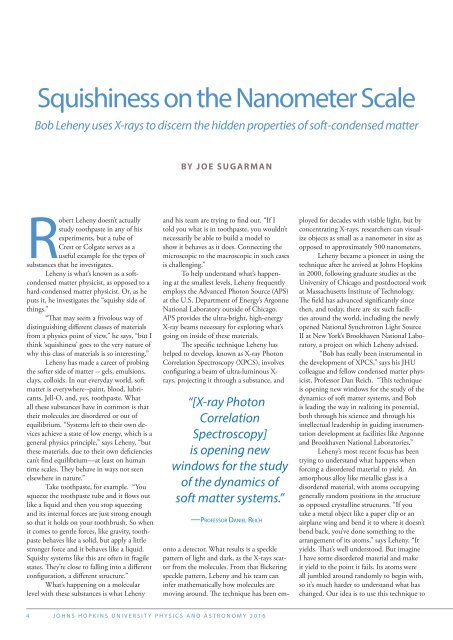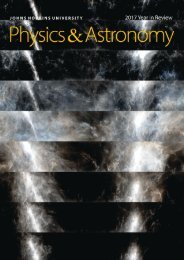2016_PA_Newsletter_12_29_16_FINAL
You also want an ePaper? Increase the reach of your titles
YUMPU automatically turns print PDFs into web optimized ePapers that Google loves.
Squishiness on the Nanometer Scale<br />
Bob Leheny uses X-rays to discern the hidden properties of soft-condensed matter<br />
BY JOE SUGARMAN<br />
Robert Leheny doesn’t actually<br />
study toothpaste in any of his<br />
experiments, but a tube of<br />
Crest or Colgate serves as a<br />
useful example for the types of<br />
substances that he investigates.<br />
Leheny is what’s known as a softcondensed<br />
matter physicist, as opposed to a<br />
hard-condensed matter physicist. Or, as he<br />
puts it, he investigates the “squishy side of<br />
things.”<br />
“That may seem a frivolous way of<br />
distinguishing different classes of materials<br />
from a physics point of view,” he says, “but I<br />
think ‘squishiness’ goes to the very nature of<br />
why this class of materials is so interesting.”<br />
Leheny has made a career of probing<br />
the softer side of matter -- gels, emulsions,<br />
clays, colloids. In our everyday world, soft<br />
matter is everywhere--paint, blood, lubricants,<br />
Jell-O, and, yes, toothpaste. What<br />
all these substances have in common is that<br />
their molecules are disordered or out of<br />
equilibrium. “Systems left to their own devices<br />
achieve a state of low energy, which is a<br />
general physics principle,” says Leheny, “but<br />
these materials, due to their own deficiencies<br />
can’t find equilibrium—at least on human<br />
time scales. They behave in ways not seen<br />
elsewhere in nature.”<br />
Take toothpaste, for example. “You<br />
squeeze the toothpaste tube and it flows out<br />
like a liquid and then you stop squeezing<br />
and its internal forces are just strong enough<br />
so that it holds on your toothbrush. So when<br />
it comes to gentle forces, like gravity, toothpaste<br />
behaves like a solid, but apply a little<br />
stronger force and it behaves like a liquid.<br />
Squishy systems like this are often in fragile<br />
states. They’re close to falling into a different<br />
configuration, a different structure.”<br />
What’s happening on a molecular<br />
level with these substances is what Leheny<br />
and his team are trying to find out. “If I<br />
told you what is in toothpaste, you wouldn’t<br />
necessarily be able to build a model to<br />
show it behaves as it does. Connecting the<br />
microscopic to the macroscopic in such cases<br />
is challenging.”<br />
To help understand what’s happening<br />
at the smallest levels, Leheny frequently<br />
employs the Advanced Photon Source (APS)<br />
at the U.S. Department of Energy’s Argonne<br />
National Laboratory outside of Chicago.<br />
APS provides the ultra-bright, high-energy<br />
X-ray beams necessary for exploring what’s<br />
going on inside of these materials.<br />
The specific technique Leheny has<br />
helped to develop, known as X-ray Photon<br />
Correlation Spectroscopy (XPCS), involves<br />
configuring a beam of ultra-luminous X-<br />
rays, projecting it through a substance, and<br />
“[X-ray Photon<br />
Correlation<br />
Spectroscopy]<br />
is opening new<br />
windows for the study<br />
of the dynamics of<br />
soft matter systems.”<br />
—Professor Daniel Reich<br />
onto a detector. What results is a speckle<br />
pattern of light and dark, as the X-rays scatter<br />
from the molecules. From that flickering<br />
speckle pattern, Leheny and his team can<br />
infer mathematically how molecules are<br />
moving around. The technique has been employed<br />
for decades with visible light, but by<br />
concentrating X-rays, researchers can visualize<br />
objects as small as a nanometer in size as<br />
opposed to approximately 500 nanometers.<br />
Leheny became a pioneer in using the<br />
technique after he arrived at Johns Hopkins<br />
in 2000, following graduate studies at the<br />
University of Chicago and postdoctoral work<br />
at Massachusetts Institute of Technology.<br />
The field has advanced significantly since<br />
then, and today, there are six such facilities<br />
around the world, including the newly<br />
opened National Synchrotron Light Source<br />
II at New York’s Brookhaven National Laboratory,<br />
a project on which Leheny advised.<br />
“Bob has really been instrumental in<br />
the development of XPCS,” says his JHU<br />
colleague and fellow condensed matter physicist,<br />
Professor Dan Reich. “This technique<br />
is opening new windows for the study of the<br />
dynamics of soft matter systems, and Bob<br />
is leading the way in realizing its potential,<br />
both through his science and through his<br />
intellectual leadership in guiding instrumentation<br />
development at facilities like Argonne<br />
and Brookhaven National Laboratories.”<br />
Leheny’s most recent focus has been<br />
trying to understand what happens when<br />
forcing a disordered material to yield. An<br />
amorphous alloy like metallic glass is a<br />
disordered material, with atoms occupying<br />
generally random positions in the structure<br />
as opposed crystalline structures. “If you<br />
take a metal object like a paper clip or an<br />
airplane wing and bend it to where it doesn’t<br />
bend back, you’ve done something to the<br />
arrangement of its atoms,” says Leheny. “It<br />
yields. That’s well understood. But imagine<br />
I have some disordered material and make<br />
it yield to the point it fails. Its atoms were<br />
all jumbled around randomly to begin with,<br />
so it’s much harder to understand what has<br />
changed. Our idea is to use this technique to<br />
4 JOHNS HOPKINS UNIVERSITY PHYSICS AND ASTRONOMY <strong>20<strong>16</strong></strong>










